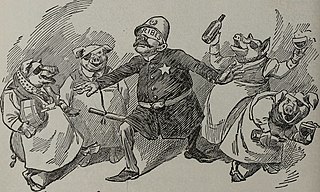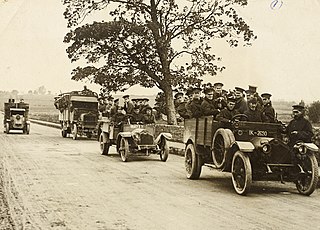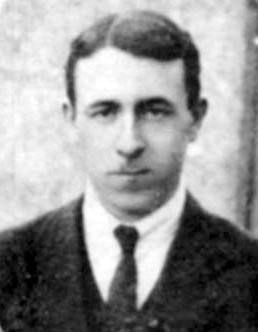Related Research Articles

The Black and Tans were constables recruited into the Royal Irish Constabulary (RIC) as reinforcements during the Irish War of Independence. Recruitment began in Great Britain in January 1920 and about 10,000 men enlisted during the conflict. The majority were unemployed former British soldiers from England who had fought in the First World War. Some sources count Irish recruits to the RIC from 1920 as 'Black and Tans'.

The Royal Ulster Constabulary (RUC) was the police force in Northern Ireland from 1922 to 2001. It was founded on 1 June 1922 as a successor to the Royal Irish Constabulary (RIC) following the partition of Ireland. At its peak the force had around 8,500 officers, with a further 4,500 who were members of the RUC Reserve.

The Royal Irish Constabulary was the police force in Ireland from 1822 until 1922, when all of the country was part of the United Kingdom. A separate civic police force, the unarmed Dublin Metropolitan Police (DMP), patrolled the capital and parts of County Wicklow, while the cities of Derry and Belfast, originally with their own police forces, later had special divisions within the RIC. For most of its history, the ethnic and religious makeup of the RIC broadly matched that of the Irish population, although Anglo-Irish Protestants were overrepresented among its senior officers.

Elizabeth Southerden Thompson, later known as Lady Butler, was a British painter who specialised in painting scenes from British military campaigns and battles, including the Crimean War and the Napoleonic Wars. Her notable works include The Roll Call, The Defence of Rorke's Drift, and Scotland Forever!. She wrote about her military paintings in an autobiography published in 1922: "I never painted for the glory of war, but to portray its pathos and heroism." She was married to British Army officer William Butler, becoming Lady Butler after he was knighted.

Police corruption is a form of police misconduct in which law enforcement officers end up breaking their political contract and abusing their power for personal gain. This type of corruption may involve one or a group of officers. Internal police corruption is a challenge to public trust, cohesion of departmental policies, human rights and legal violations involving serious consequences. Police corruption can take many forms, such as: bribery, theft, sexual assault, and discrimination.

The Independent Commission Against Corruption is the statutory independent anti-corruption body of Hong Kong with the primary objective of combating corruption in both the public and private sectors. Established in 1974 and operating independently from the Hong Kong government and law enforcement agencies, the ICAC is headed by the Commissioner, who reports directly to the Chief Executive of Hong Kong. The ICAC has played a crucial role in maintaining Hong Kong's reputation as one of the least corrupt places globally and fostering a culture of integrity within the city.

Sallie-Anne Huckstepp was an Australian writer, sex worker and whistleblower, who was the victim of an underworld homicide. She came to attention in 1981 for speaking out about police corruption in Sydney, Australia. Huckstepp's murder remains unsolved.

This is a timeline of the Irish War of Independence of 1919–21. The Irish War of Independence was a guerrilla conflict and most of the fighting was conducted on a small scale by the standards of conventional warfare.
Clonoulty is a small village and a civil parish in County Tipperary, Ireland. It is one of nine civil parishes in the barony of Kilnamanagh Lower. It is also one half of the ecclesiastical parish of Clonoulty-Rossmore in the Roman Catholic Archdiocese of Cashel and Emly. Clonoulty may also refer to a slightly larger area which forms one half of the catchment area for Clonoulty-Rossmore GAA club.

Bansha is a village in County Tipperary in Ireland. The village is part of the parish of "Bansha and Kilmoyler" in the Roman Catholic Archdiocese of Cashel and Emly. It is in the historical barony of Clanwilliam. Bansha is co-extensive with the pre-Reformation parish of Templeneiry of which the townland name of Templenahurney is thought to be a corruption. While the village is the focal point of the area, there is also an outlying hamlet in the parish, located at Rossadrehid where a rural creamery once serviced the dairy industry.

Galtee Rovers—St. Pecaun's is a Gaelic Athletic Association club located in the village of Bansha on the National Primary Route N24 in the shadow of the Galtee Mountains in west County Tipperary, Ireland. The club, founded in 1885, represents the parish of Bansha & Kilmoyler and enters gaelic football and hurling teams in the West Tipperary and Tipperary championships. The club grounds – Canon Hayes Park – are named in honour of the founder of Muntir na Tíre, Very Rev. John Canon Hayes, Parish Priest of Bansha & Kilmoyler (1946–57), who was patron of the club during his pastorship. The club pavilion is named 'The McGrath Centre' in honour of two club members, the late John & Geraldine McGrath who died on New Year's Day, 1 January 2000. John Moloney, referee of six All-Ireland Senior Finals, was President of the Galtee Rovers Club at the time of his death on 6 October 2006. In addition to his work at national level in the Gaelic Athletic Association, at club level he coached and organised the juvenile and under-age players for nearly 50 years.
Prostitution in Ireland is legal. However, since March 2017, it has been an offence to buy sex. All forms of third party involvement are illegal but are commonly practiced. Since the law that criminalises clients came into being, with the purpose of reducing the demand for prostitution, the number of prosecutions for the purchase of sex increased from 10 in 2018 to 92 in 2020. In a report from UCD's Sexual Exploitation Research Programme the development is called ”a promising start in interrupting the demand for prostitution.” Most prostitution in Ireland occurs indoors. Street prostitution has declined considerably in the 21st century, with the vast majority of prostitution now advertised on the internet.

Seán Hogan was one of the leaders of the 3rd Tipperary Brigade of the Irish Republican Army during the War of Independence.

Lieutenant-Colonel Gerald Bryce Ferguson Smyth, DSO and Bar, French Croix de Guerre and Belgian Croix de guerre was a British Army officer and police officer who was at the centre of a mutiny in the ranks of the Royal Irish Constabulary during the Irish War of Independence. He was shot and killed by the Irish Republican Army in Cork in 1920.
Thomas St George McCarthy (1862–1943) was an Ireland rugby union international and founder member of the Gaelic Athletic Association, being present at Hayes Hotel, Thurles, County Tipperary, Ireland at the Association's inaugural meeting on 1 November 1884. He was born at Bansha, Tipperary. His father, George McCarthy (1832–1902), Lieutenant of the Revenue Police, County Inspector of the RIC and Resident Magistrate, was from County Kerry.

Denis Lacey was an Irish Republican Army officer during the Irish War of Independence and anti-Treaty IRA officer during the Irish Civil War.

Anti-Catholicism in the United Kingdom dates back to Roman times. Attacks on the Church from a Protestant angle mostly began with the English and Irish Reformations which were launched by King Henry VIII and the Scottish Reformation which was led by John Knox. Within England, the Act of Supremacy 1534 declared the English crown to be "the only supreme head on earth of the Church in England" in place of the Pope. Any act of allegiance to the latter was considered treasonous because the papacy claimed both spiritual and political power over its followers. Ireland was brought under direct English control starting in 1536 during the Tudor conquest of Ireland. The Scottish Reformation in 1560 abolished Catholic ecclesiastical structures and rendered Catholic practice illegal in Scotland. Today, anti-Catholicism remains common in the United Kingdom, with particular relevance in Scotland and Northern Ireland.
The Arnon Street killings, also referred to as the Arnon Street murders or the Arnon Street massacre, took place on 1 April 1922 in Belfast, Northern Ireland. Six Catholic civilians, three in Arnon Street, were shot or beaten to death by men who broke into their homes. It is believed that policemen carried out the attack, members of either the Ulster Special Constabulary (USC) or Royal Irish Constabulary (RIC), in retaliation for the killing of an RIC officer by the Irish Republican Army (IRA).
On 13 May 1919, a captured Irish Republican Army (IRA) member, Seán Hogan, was rescued from a train by his comrades while being guarded by four armed Royal Irish Constabulary (RIC) officers. Two of the RIC officers were killed and several IRA volunteers were wounded. The rescue took place on Hogan's 18th birthday, while the Cork-bound train stopped at Knocklong station in County Limerick. It was undertaken by three of Hogan's comrades from the 3rd Tipperary Brigade of the IRA and five members of the Galtee Battalion of the East Limerick Brigade. Hogan was one of the most wanted men in Ireland at the time of his rescue, due to his role in the Soloheadbeg ambush and would almost certainly have been executed.